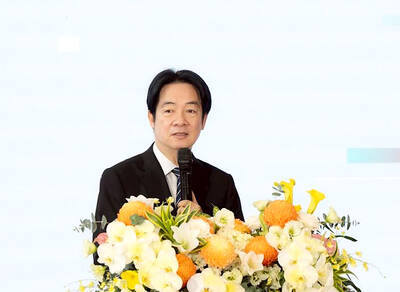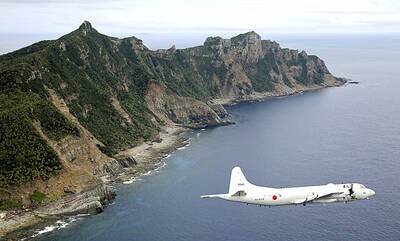Chinese bombers. Chinese hypersonic missiles. Chinese cyberattacks. Chinese anti-satellite weapons.
To a remarkable degree, the Pentagon budget proposal for next year is shaped by national security threats that Acting US Secretary of Defense Patrick Shanahan has summarized in three words: “China, China, China.”
The US is still fighting small wars against extremists and Russia remains a serious concern, but Shanahan seeks to shift the military’s main focus to what he considers the more pressing security problem of a rapidly growing Chinese military.

Photo: AP
This theme, which Shanahan outlined on Thursday in presenting the administration’s proposed defense budget to the US Senate Armed Services Committee, is competing for attention with narrower, more immediate problems, such as US President Donald Trump’s effort to use the military to build a border wall.
Shanahan is hardly the first defense chief to worry about China.
However, he sees it as an increasingly urgent problem that exceeds traditional measures of military strength and transcends partisan priorities.
“We’ve been ignoring the problem for too long,” Shanahan told a US senator.
“China is aggressively modernizing its military, systematically stealing science and technology, and seeking military advantage through a strategy of military-civil fusion,” he wrote in prepared testimony to the committee, which is considering a US$718 billion Pentagon budget designed in part to counter China’s momentum.
The US$25 billion that the Pentagon is proposing to spend on nuclear weapons, for example, is meant in part to stay ahead of China’s nuclear arsenal, which is much smaller than the US’, but growing.
Shanahan said China is developing a nuclear-capable long-range bomber that, if successful, would enable China to join the US and Russia as the only nations with air, sea and land-based nuclear weapons.
Shanahan ticked off a list of other Chinese advancements — hypersonic missiles against which the US has limited defenses, space launches and other space efforts that could enable it to fight wars in space, “systematically stealing” of US and allied technology, and militarizing land features in the South China Sea.
Bonnie Glaser, director of the China Power Project at the Center for Strategic and International Studies, said that the US has been lacking effective strategies for competing with China on a broad scale.
“It is overdue,” she said of the Shanahan focus. “We have been somewhat slow in catching up” in such areas as denying China its regional ambitions, including efforts to fully control the South China Sea, which is contested by several other countries.
However, some defense analysts said Shanahan and the Pentagon have inflated the China threat.
“I do think it’s worth asking what exactly is threatening about China’s behavior,” said Christopher Preble, vice president for defense and foreign policy studies at the Cato Institute.
He does not discount China as a security issue, including in the South China Sea, but doubts the US military is the institution best suited to deal with such non-military problems as cyberintrusions into US commercial networks.
Competition with the Chinese is not mainly military, Preble said.
“I still don’t believe the nature of the threat is quite as grave as we’re led to believe” by the Pentagon, he said. “They tend to exaggerate the nature of the threat today.”

MISINFORMATION: The generated content tends to adopt China’s official stance, such as ‘Taiwan is currently governed by the Chinese central government,’ the NSB said Five China-developed artificial intelligence (AI) language models exhibit cybersecurity risks and content biases, an inspection conducted by the National Security Bureau (NSB) showed. The five AI tools are: DeepSeek, Doubao (豆包), Yiyan (文心一言), Tongyi (通義千問) and Yuanbao (騰訊元寶), the bureau said, advising people to remain vigilant to protect personal data privacy and corporate business secrets. The NSB said it, in accordance with the National Intelligence Services Act (國家情報工作法), has reviewed international cybersecurity reports and intelligence, and coordinated with the Ministry of Justice Investigation Bureau and the National Police Agency’s Criminal Investigation Bureau to conduct an inspection of China-made AI language

LIMITS: While China increases military pressure on Taiwan and expands its use of cognitive warfare, it is unwilling to target tech supply chains, the report said US and Taiwan military officials have warned that the Chinese People’s Liberation Army (PLA) could implement a blockade within “a matter of hours” and need only “minimal conversion time” prior to an attack on Taiwan, a report released on Tuesday by the US Senate’s China Economic and Security Review Commission said. “While there is no indication that China is planning an imminent attack, the United States and its allies and partners can no longer assume that a Taiwan contingency is a distant possibility for which they would have ample time to prepare,” it said. The commission made the comments in its annual

‘TROUBLEMAKER’: Most countries believe that it is China — rather than Taiwan — that is undermining regional peace and stability with its coercive tactics, the president said China should restrain itself and refrain from being a troublemaker that sabotages peace and stability in the Indo-Pacific region, President William Lai (賴清德) said yesterday. Lai made the remarks after China Coast Guard vessels sailed into disputed waters off the Senkaku Islands — known as the Diaoyutai Islands (釣魚台) in Taiwan — following a remark Japanese Prime Minister Sanae Takaichi made regarding Taiwan. Takaichi during a parliamentary session on Nov. 7 said that a “Taiwan contingency” involving a Chinese naval blockade could qualify as a “survival-threatening situation” for Japan, and trigger Tokyo’s deployment of its military for defense. Asked about the escalating tensions

DISPUTE: A Chinese official prompted a formal protest from Tokyo by saying that ‘the dirty head that sticks itself out must be cut off,’ after Takaichi’s Taiwan remarks Four armed China Coast Guard vessels yesterday morning sailed through disputed waters controlled by Japan, amid a diplomatic spat following Japanese Prime Minister Sanae Takaichi’s comments on Taiwan. The four ships sailed around the Senkaku Islands — known as the Diaoyutai Islands (釣魚台) to Taiwan, and which Taiwan and China also claim — on Saturday before entering Japanese waters yesterday and left, the Japan Coast Guard said. The China Coast Guard said in a statement that it carried out a “rights enforcement patrol” through the waters and that it was a lawful operation. As of the end of last month,